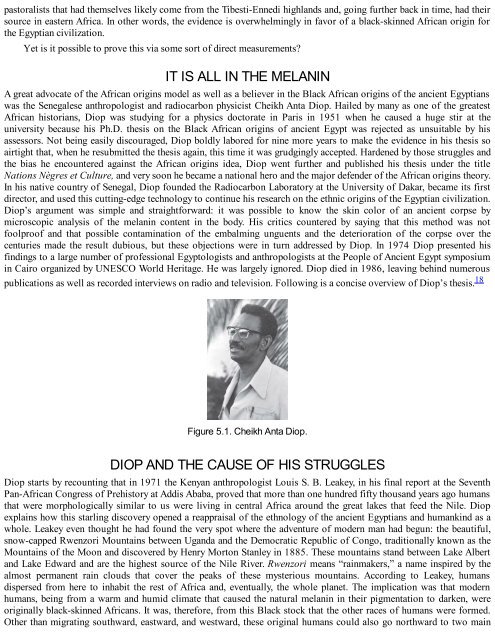Black Genesis: The Prehistoric Origins of Ancient Egypt
Black Genesis: The Prehistoric Origins of Ancient Egypt
Black Genesis: The Prehistoric Origins of Ancient Egypt
Create successful ePaper yourself
Turn your PDF publications into a flip-book with our unique Google optimized e-Paper software.
pastoralists that had themselves likely come from the Tibesti-Ennedi highlands and, going further back in time, had their<br />
source in eastern Africa. In other words, the evidence is overwhelmingly in favor <strong>of</strong> a black-skinned African origin for<br />
the <strong>Egypt</strong>ian civilization.<br />
Yet is it possible to prove this via some sort <strong>of</strong> direct measurements?<br />
IT IS ALL IN THE MELANIN<br />
A great advocate <strong>of</strong> the African origins model as well as a believer in the <strong>Black</strong> African origins <strong>of</strong> the ancient <strong>Egypt</strong>ians<br />
was the Senegalese anthropologist and radiocarbon physicist Cheikh Anta Diop. Hailed by many as one <strong>of</strong> the greatest<br />
African historians, Diop was studying for a physics doctorate in Paris in 1951 when he caused a huge stir at the<br />
university because his Ph.D. thesis on the <strong>Black</strong> African origins <strong>of</strong> ancient <strong>Egypt</strong> was rejected as unsuitable by his<br />
assessors. Not being easily discouraged, Diop boldly labored for nine more years to make the evidence in his thesis so<br />
airtight that, when he resubmitted the thesis again, this time it was grudgingly accepted. Hardened by those struggles and<br />
the bias he encountered against the African origins idea, Diop went further and published his thesis under the title<br />
Nations Nègres et Culture, and very soon he became a national hero and the major defender <strong>of</strong> the African origins theory.<br />
In his native country <strong>of</strong> Senegal, Diop founded the Radiocarbon Laboratory at the University <strong>of</strong> Dakar, became its first<br />
director, and used this cutting-edge technology to continue his research on the ethnic origins <strong>of</strong> the <strong>Egypt</strong>ian civilization.<br />
Diop’s argument was simple and straightforward: it was possible to know the skin color <strong>of</strong> an ancient corpse by<br />
microscopic analysis <strong>of</strong> the melanin content in the body. His critics countered by saying that this method was not<br />
foolpro<strong>of</strong> and that possible contamination <strong>of</strong> the embalming unguents and the deterioration <strong>of</strong> the corpse over the<br />
centuries made the result dubious, but these objections were in turn addressed by Diop. In 1974 Diop presented his<br />
findings to a large number <strong>of</strong> pr<strong>of</strong>essional <strong>Egypt</strong>ologists and anthropologists at the People <strong>of</strong> <strong>Ancient</strong> <strong>Egypt</strong> symposium<br />
in Cairo organized by UNESCO World Heritage. He was largely ignored. Diop died in 1986, leaving behind numerous<br />
publications as well as recorded interviews on radio and television. Following is a concise overview <strong>of</strong> Diop’s thesis. 18<br />
Figure 5.1. Cheikh Anta Diop.<br />
DIOP AND THE CAUSE OF HIS STRUGGLES<br />
Diop starts by recounting that in 1971 the Kenyan anthropologist Louis S. B. Leakey, in his final report at the Seventh<br />
Pan-African Congress <strong>of</strong> Prehistory at Addis Ababa, proved that more than one hundred fifty thousand years ago humans<br />
that were morphologically similar to us were living in central Africa around the great lakes that feed the Nile. Diop<br />
explains how this starling discovery opened a reappraisal <strong>of</strong> the ethnology <strong>of</strong> the ancient <strong>Egypt</strong>ians and humankind as a<br />
whole. Leakey even thought he had found the very spot where the adventure <strong>of</strong> modern man had begun: the beautiful,<br />
snow-capped Rwenzori Mountains between Uganda and the Democratic Republic <strong>of</strong> Congo, traditionally known as the<br />
Mountains <strong>of</strong> the Moon and discovered by Henry Morton Stanley in 1885. <strong>The</strong>se mountains stand between Lake Albert<br />
and Lake Edward and are the highest source <strong>of</strong> the Nile River. Rwenzori means “rainmakers,” a name inspired by the<br />
almost permanent rain clouds that cover the peaks <strong>of</strong> these mysterious mountains. According to Leakey, humans<br />
dispersed from here to inhabit the rest <strong>of</strong> Africa and, eventually, the whole planet. <strong>The</strong> implication was that modern<br />
humans, being from a warm and humid climate that caused the natural melanin in their pigmentation to darken, were<br />
originally black-skinned Africans. It was, therefore, from this <strong>Black</strong> stock that the other races <strong>of</strong> humans were formed.<br />
Other than migrating southward, eastward, and westward, these original humans could also go northward to two main


